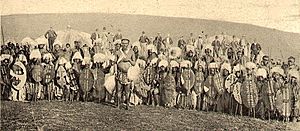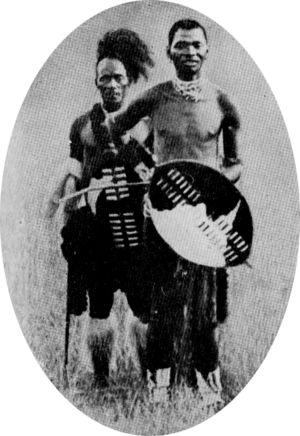Bambatha Rebellion facts for kids
Quick facts for kids Bambatha rebellion |
|||||||
|---|---|---|---|---|---|---|---|
| Part of the aftermath of the Anglo-Zulu War | |||||||
|
Zulu warriors |
|||||||
|
|||||||
| Belligerents | |||||||
|
amaZondi and amaCube clans of the Zulu people | ||||||
| Commanders and leaders | |||||||
|
Colonel Duncan McKenzie |
Chief Bambatha kaMancinza | ||||||
| Strength | |||||||
| 4,316 soldiers (including 2,978 Militia) | Unknown | ||||||
| Casualties and losses | |||||||
| 36 (including 6 levies) | 3,000 to 4,000 killed | ||||||
The Bambatha Rebellion (also called the Zulu Rebellion) happened in 1906. It was led by Bambatha kaMancinza, a chief of the Zondi clan of the Zulu people. He lived in the Mpanza Valley in Natal, South Africa. The rebellion was against British rule and new taxes in the area.
Contents
What Caused the Bambatha Rebellion?
After the Anglo-Boer War, British employers in Natal found it hard to find enough black farm workers. This was because many workers preferred to go to the gold mines of the Witwatersrand.
To make more Zulu men work, the British colonial government introduced a new tax called a poll tax. This tax was £1 for every adult man, on top of other taxes. Chief Bambatha, who led about 5,500 people, was one of the chiefs who did not want to pay this new tax.
How the Rebellion Started
The Natal government sent police officers to collect the tax from areas that refused to pay. In February 1906, two British officers were killed near Richmond, KwaZulu-Natal. Because of this, the government declared martial law, which meant the military took control.
Bambatha then went north to talk with King Dinuzulu, the Zulu king. King Dinuzulu quietly supported Bambatha and let him and his family stay at the royal home.
Bambatha returned to the Mpanza Valley and found that the Natal government had removed him as chief. He gathered a small group of supporters. They started launching guerrilla attacks, hiding in the Nkandla forest.
The Battle at Mome Gorge
After some early successes, colonial troops led by Colonel Duncan McKenzie began a large operation in April 1906. The British soldiers managed to find and surround the rebels at Mome Gorge.
As the sun rose, the colonial soldiers opened fire with machine guns and cannons. Most of the rebels only had traditional weapons like assegais (spears), knobkerries (fighting sticks), and cowhide shields.
Bambatha was killed and beheaded during this battle. However, many of his followers believed he was still alive, and his wife did not go into mourning. Bambatha's main ally, 95-year-old Zulu leader Inkosi Sigananda Shezi, was captured and died a few days later.
Aftermath of the Rebellion
Between 3,000 and 4,000 Zulus were killed during the revolt. More than 7,000 were put in prison, and 4,000 were whipped as punishment. King Dinizulu was arrested and sent to prison for four years because of treason. The war cost the Natal government a lot of money, about £883,576.
Mahatma Gandhi's Part in the Rebellion
Mohandas Karamchand Gandhi was in South Africa during this time. He believed that Indians in South Africa should help the British Empire during the Zulu uprising. Gandhi encouraged the British to let Indians join the army. He thought that if Indians supported the war, it would help them gain full citizenship rights.
The British did not allow Indians to become army officers. However, they accepted Gandhi's offer to create a group of Indian volunteers to act as stretcher bearers. This group of 21 people, led by Gandhi, helped treat wounded British soldiers. Gandhi wrote in his newspaper, Indian Opinion, that Indians should join the war effort. Later, in 1927, he described the event as "No war but a man hunt."
Remembering the Rebellion
In 2006, the 100th anniversary of the rebellion was celebrated. Chief Bambatha was declared a national hero of post-Apartheid South Africa. His picture appeared on a postage stamp, and a street was renamed in his honor.
During the ceremony, some speeches suggested that the body found was not really Bambatha's. Many people still believe that the chief managed to escape to Mozambique. A DNA test of the body did not give a clear answer.
The hip-hop musician Afrika Bambaataa got his name from Bambatha and his rebellion.
See also
 In Spanish: Rebelión de Bambatha para niños
In Spanish: Rebelión de Bambatha para niños



